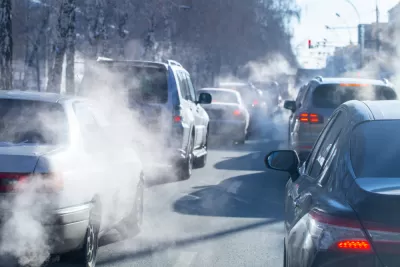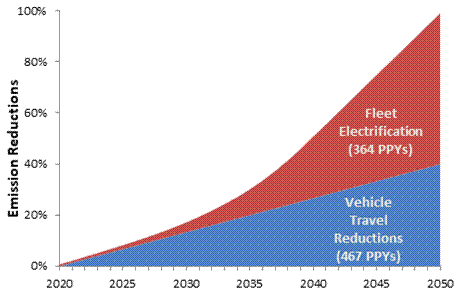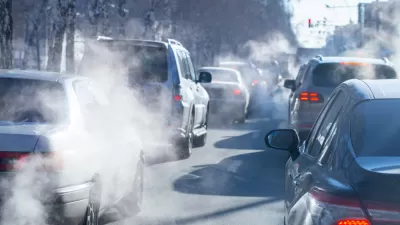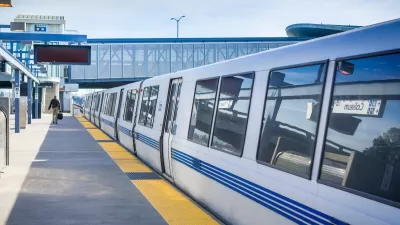Many jurisdictions have ambitious greenhouse gas emission reduction targets and are developing plans to achieve them. This column discusses the factors that should be considered in this planning process.

Many jurisdictions have ambitious greenhouse gas emission reduction targets and are developing plans to achieve them. Since transportation is one of the largest emission sources, it is a major component of these plans.
There are many possible ways to reduce transportation emissions. These include clean vehicle strategies that reduce emission rates per vehicle mile, and transportation demand management (TDM) and Smart Growth policies that reduce total vehicle travel, as summarized below.
Types of Emission Reduction Strategies
Clean Vehicles |
Vehicle Travel Reductions |
|
Technologies and policies that reduce emission rates per vehicle-mile |
TDM and Smart Growth policies that reduce total vehicle travel |
|
|
Clean vehicle strategies reduce per-mile emission rates. Vehicle travel reduction strategies reduce total vehicle mileage.
Which strategies are most effective and beneficial overall? That depends on how they are analyzed, including the scope of impacts considered and the methods used to predict those impacts. My new report, Comprehensive Transportation Emission Reduction Planning: Guidelines for Evaluating Transportation Emission Reduction Strategies, explores these issues. It identifies ten factors that should be considered when evaluating and prioritizing potential transportation emission reduction strategies, as summarized in the table below.
Factors to Consider in Emission Reduction Evaluation
Factor |
Description |
Methods |
Effect if Ignored |
|
Embodied emissions |
Emissions from vehicles, batteries, fuel and infrastructure production. |
Apply lifecycle analysis that accounts for all emissions. |
Exaggerates clean vehicles emission reductions. |
|
Rebound effects |
Additional vehicle travel and size caused by reduced operating costs, and the increased external costs that result. |
Account for rebound effects and the additional external costs that result. |
Exaggerates clean vehicles emission reductions and benefits. |
|
Implementation costs and subsidies |
Consider all costs of developing, producing and operating clean vehicles and their infrastructure. |
Consider all costs when evaluating and comparing strategies. |
Tends to underestimate clean vehicle total costs. |
|
Realistic fleet penetration predictions |
The time needed for clean vehicles to penetrate vehicle fleets and travel. |
Use realistic fleet and travel predictions. |
Optimistic predictions exaggerate clean vehicle emission reductions. |
|
Leverage and synergistic effects |
Additional vehicle travel reductions provided by integrated TDM and Smart Growth programs. |
Consider leverage and synergistic effects in modelling and analysis. |
Undervalues integrated TDM and Smart Growth programs. |
|
Comprehensive vehicle travel reduction strategies |
The variety of TDM and Smart Growth strategies considered in analysis. |
Consider all potentially effective TDM and Smart Growth strategies. |
Overlooking cost effective TDM strategies undervalues vehicle travel reduction solutions. |
|
Indirect costs and co-benefits |
The range of impacts considered in the analysis, including indirect costs and co-benefits. |
Account for all significant impacts, including indirect and long term effects. |
Overlooking these impacts tends to undervalue vehicle travel reduction strategies. |
|
Cost efficiency |
Comparison of unit costs, such as dollars per tonne of emissions reduced. |
Compare total unit costs between strategies. |
Favors clean vehicles over vehicle travel reductions. |
|
Latent demand for multimodal lifestyles |
The portion of travellers who want to rely more on non-auto modes and live in more multimodal communities. |
Consider growing consumer demands for non-auto travel and walkable communities. |
Ignoring this factor undervalues TDM and Smart Growth strategies. |
|
State-of-Art models |
The quality of models used to predict travel and emission impacts. |
Use up-to-date integrated models. |
Outdated models tend to undervalue vehicle travel reduction strategies. |
These factors should be considered when evaluating transportation emission reduction strategies. Failing to account for them tends to bias emission reduction planning.
As part of this study I reviewed more than two dozen emission reduction plans. I found that most plans are biased in ways that favor clean vehicle subsidies over vehicle travel reduction strategies. For example, few account for embodied emissions, rebound effects, TDM and Smart Growth co-benefits, or the very long time period required for clean vehicles to penetrate the fleet. Many plans assume that clean vehicle strategies are more effective, cost effective, fast, reliable, and popular than vehicle travel reductions. My research challenges those assumptions.
This is not to suggest that clean vehicle strategies are bad and should be rejected. However, this research indicates that their emission reductions are often smaller than predicted. Considering embodied energy, clean vehicles typically reduce per-mile emission rates by half to three quarters, and their annual emission reductions are even smaller due to induced vehicle travel which increases their emissions and external costs. In fact, a large electric SUV or light truck has total emissions comparable to a small gasoline car. As a result, it is an exaggeration to call electric or hydrogen vehicles “zero emissions;” it is more accurate to call them “lower-emission” and “elsewhere-emission” vehicles.
Lifecycle Emissions

Clean vehicles have relatively high unit costs per tonne of emissions reduced, and require significant subsidies. On the other hand, vehicle travel reduction strategies often provide additional, but often overlooked benefits and respond to latent consumer demands for non-auto travel, and tend to be very cost effective.
In 2021, hybrid and electric vehicles represented about 3% of new vehicle sales, and these are mainly cars due to slower development of electric SUVs, light truck and vans. Optimistically, half of new vehicles could be electric by 2030 but realistically it will take longer, and the remaining fossil fuel vehicles will skew to low fuel economy. With current policies, the fleet is unlikely to be fully electric by 2050, as illustrated below.

Many TDM strategies can be implemented quickly, reducing emissions far faster than clean vehicle implementation. An integrated set of TDM and Smart Growth strategies can reduce transportation emissions by 20-50 percent in ways that are cost-effective and beneficial overall, considering all impacts.
The figure below indicates predicted emission reductions that can be achieved by clean vehicles and vehicle travel reductions.
Comparing Emission Reductions

This analysis suggests that to be efficient and equitable transportation emission reduction plans should rely at least as much on vehicle travel reductions as on clean vehicle strategies, with particular emphasis on “quick win” strategies that can be implemented in a few years.
There is a positive message here. With better analysis we can identify true win-win emission reduction strategies that also help achieve other economic, social and environmental goals.

Planetizen Federal Action Tracker
A weekly monitor of how Trump’s orders and actions are impacting planners and planning in America.

Map: Where Senate Republicans Want to Sell Your Public Lands
For public land advocates, the Senate Republicans’ proposal to sell millions of acres of public land in the West is “the biggest fight of their careers.”

Restaurant Patios Were a Pandemic Win — Why Were They so Hard to Keep?
Social distancing requirements and changes in travel patterns prompted cities to pilot new uses for street and sidewalk space. Then it got complicated.

Platform Pilsner: Vancouver Transit Agency Releases... a Beer?
TransLink will receive a portion of every sale of the four-pack.

Toronto Weighs Cheaper Transit, Parking Hikes for Major Events
Special event rates would take effect during large festivals, sports games and concerts to ‘discourage driving, manage congestion and free up space for transit.”

Berlin to Consider Car-Free Zone Larger Than Manhattan
The area bound by the 22-mile Ringbahn would still allow 12 uses of a private automobile per year per person, and several other exemptions.
Urban Design for Planners 1: Software Tools
This six-course series explores essential urban design concepts using open source software and equips planners with the tools they need to participate fully in the urban design process.
Planning for Universal Design
Learn the tools for implementing Universal Design in planning regulations.
Heyer Gruel & Associates PA
JM Goldson LLC
Custer County Colorado
City of Camden Redevelopment Agency
City of Astoria
Transportation Research & Education Center (TREC) at Portland State University
Camden Redevelopment Agency
City of Claremont
Municipality of Princeton (NJ)






























